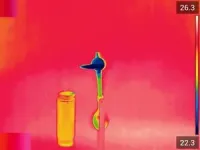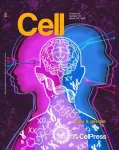(Press-News.org) Inspired by the classic drinking bird toy, scientists in Hong Kong and Guangzhou, China have developed an engine that efficiently converts energy from water evaporation into electricity to power small electronics. The device produces energy outputs exceeding 100 volts—much higher than other techniques that generate electricity from water—and can operate for several days using only 100 milliliters of water as fuel, according to a study published March 14 in the journal Device.
“The drinking bird triboelectric hydrovoltaic generator offers a unique means to power small electronics in ambient conditions, utilizing water as a readily available fuel source,” said Hao Wu, a professor at South China University of Technology and the first author of the study. “I still feel surprised and excited when witnessing the actual results.”
The drinking bird toy, also called a “dippy bird,” has been a fixture of science classrooms for decades. The toy consists of two glass bulbs connected by a glass tube with a highly volatile liquid, methylene chloride, stored within. The top bulb, which includes the bird’s beak and a decorative top hat, is covered in a felt-like material, and the bird’s body is suspended on two plastic legs. After the bird’s head is dipped in a glass of water, the water begins to evaporate. This results in a pressure difference that causes the fluid in the bottom bulb to rise through the tube until it fills the head, causing the bird to dip forward into the water to “take a drink” before the process starts again.
When Wu was a postdoc in Prof. Zuankai Wang’s group at The Hong Kong Polytechnic University puzzling over how to create a greater voltage output from an evaporation energy generator, she remembered the drinking bird toy and was struck by the idea that it could be used as more than a tool to demonstrate a physics concept.
“I began to contemplate whether we could convert the evaporation energy into mechanical energy first, and then translate it into electricity,” said Wu. “It was then that the idea of utilizing the drinking bird toy came to mind. With this inspiration, the concept of the drinking bird triboelectric hydrovoltaic generator was born.”
To construct the generator, Wu and colleagues placed two triboelectric nanogenerator modules—which collect mechanical energy—on both sides of a drinking bird engine that they reconstructed from a commercial drinking bird toy. The researchers tested the prototype with a variety of small electronics, using it to power 20 liquid crystal displays (LCDs), temperature sensors, and calculators.
Overcoming friction that slowed down the generator was a major challenge in the study, said Wu. The researchers affixed patterned fibers as the charge transfer materials in the triboelectric nanogenerator modules, a strategy that helped to reduce friction and allowed the device to operate more smoothly.
In the next phase of their research, the team plans to design a new drinking bird instead of using a commercially available toy, with the goal of converting water evaporation to electrical energy more efficiently.
“Additionally, we will explore various application opportunities for this device with the ultimate aim of delivering a practical product that can be used in our daily lives,” said Zuankai Wang, the corresponding author of this study and a chair professor at Hong Kong Polytechnic University.
###
This work was supported by the Research Grants Council of Hong Kong, the Meituan Green Tech Fund, and the New Cornerstone Science Foundation.
Device, Wu, Zheng, and Qin et al. “Drinking bird-enabled triboelectric hydrovoltaic generator” https://cell.com/device/fulltext/S2666-9986(24)00108-X
Device (@Device_CP) is a physical science journal from Cell Press along with Chem, Joule, and Matter. Device aims to be the breakthrough journal to support device- and application-oriented research from all disciplines, including applied physics, applied materials, nanotechnology, robotics, energy research, chemistry, and biotechnology, under a single title that focuses on the integration of these diverse disciplines in the creation of the cutting-edge technology of tomorrow. Visit http://www.cell.com/device/home. To receive Cell Press media alerts, contact press@cell.com.
END
Cell, the flagship biology journal of Cell Press, presents a landmark issue on sex and gender in science. It includes a collection of articles on topics related to strategies for promoting gender equality in academia, enhancing rigor in the study of sex-related variables, and supporting transgender researchers. The special content, scheduled to appear online on March 14, 2024, also discusses the past, present, and future of research on sex and gender.
To mark the occasion, Cell Press’s parent company, Elsevier, is announcing updated guidelines on reporting ...
A group of 24 transgender (and/or family members of transgender) scientists describe what it’s like to be a transgender person in STEMM. In a commentary publishing on March 14 in the journal Cell, they discuss the historical origins of trans marginalization, explain how this affects trans people’s careers in science and medicine, and lay out actions that cisgender individuals and institutions can take to support trans people in STEMM.
This first-of-its-kind commentary appears in a sex and gender focus issue of Cell, covering topics such as gender equity, the history ...
Contrary to common belief, not all vertebrates regulate their sleep-wake rhythm in the same way. University of Basel researchers have discovered that some fish – unlike humans – do not need orexin to stay awake. This molecule was thought to be necessary for normal wake and sleep rhythms in vertebrates. Humans without orexin suffer from narcolepsy.
Until recently, it was assumed that vertebrates share similar mechanisms controlling sleep behavior. That's why researchers have been using fish in the past 20 years as a model organism to study sleep ...
After the egg has been fertilized by a sperm, the surrounding egg coat tightens, mechanically preventing the entry of additional sperm and the ensuing death of the embryo. This is according to a new study led by researchers at Karolinska Institutet and published in the journal Cell. The work also explains how mutations in egg coat proteins can cause female infertility and may eventually lead to new contraceptive methods.
Fertilization in mammals begins when a sperm attaches to the egg coat, a filamentous extracellular envelope that sperm must penetrate ...
About The Study: Teen pregnancy was associated with future premature mortality in this study of 2.2 million female teenagers. It should be assessed whether supports for female teenagers who experience a pregnancy can enhance the prevention of subsequent premature mortality in young and middle adulthood.
Authors: Joel G. Ray, M.D., M.Sc., of the University of Toronto, is the corresponding author.
To access the embargoed study: Visit our For The Media website at this link https://media.jamanetwork.com/
(doi:10.1001/jamanetworkopen.2024.1833)
Editor’s Note: Please see the article for additional information, including other authors, author contributions ...
About The Study: In this study of partners and adult children of stroke survivors, risks of several mental health conditions and self-harm or suicide were moderately higher compared with the general population and, to a lesser extent, partners and adult children of heart attack survivors. These findings highlight the potential consequences of stroke among family members, particularly partners, and its findings may possibly serve as a quantitative foundation for the development of future stroke rehabilitation services.
Authors: Nils Skajaa, Ph.D., of Aarhus University Hospital in Aarhus, Denmark, is the corresponding author.
To ...
When it comes to nurturing their young, mother chimpanzees go the extra mile, according to a new study. Using 10 years of observational data on wild chimpanzees, researchers found that while adults often play, and young chimps play a lot, when food gets scarce, the adults put mutual play aside and focus on survival.
But in the meantime, mother chimps continue to be their offspring’s primary playmate, tickling, chasing, playing ‘airplane’. That suggests the mother chimps take on an indispensable role ...
It’s no secret that smoking is extremely detrimental to health. Tobacco smoke contains thousands of chemicals, including carcinogens, increasing the risk of cancer, cardiovascular and respiratory diseases.
A new study from the University of Chicago analyzed data from more than 900 samples of nine different human tissue types to understand just how deep the cellular and genetic damage from smoking goes. The research team generated epigenetic data to assess the effects of smoking on DNA methylation, or genetic locations where a handful ...
The pregnancy and post-partum experience is stressful, but for pregnant adolescents the barriers to accessing supportive care can have fatal consequences.
A recent study from The Hospital for Sick Children (SickKids) identified that compared with those who had no teen pregnancy, teenagers in Ontario who experienced a pregnancy were at a 50 per cent higher risk of premature death before the age of 31. This risk was even higher for people who had two or more teen pregnancies and amongst those who were pregnant before 16 years of age.
Published in JAMA Network Open, the study also found that ...
Researchers from Tokyo Medical and Dental University (TMDU) uncover the specific protein interactions needed for cells to break down and remove damaged mitochondria
Tokyo, Japan – Autophagy is a process used by cells as a recycling system to transport and break down organelles and other cytosolic components, which become enveloped in a membrane called the autophagosome (Fig 1). When this involves the removal of damaged mitochondria, commonly called the “powerhouse” of the cell, it is known as mitophagy. In a recent article ...






